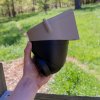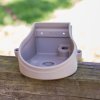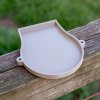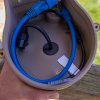I’m working on building a camera system for a large rural property, and will do my best to document the process in this thread for those who might be interested. Should be fun! Also, this is my first post to the form, and I wanted to say thank you to all the people who have shared their knowledge on this topic. Very helpful.
I’m going to start at the beginning with the project goals, and then move onto some specifics of the property, and the challenges those bring. Right now, I’m still planning and testing, anything here could change if it turns out to be suboptimal!
To understand the below discussions, the property is mostly wooded and has a public roadway along the border.
The project goals, listed with highest priority first:
Detection:
Think driveway alarm. This is the primary goal, to know when something happens so that it can be addressed in real time, instead of investigated later. Now, there is a point of contention that a separate alarm system should be used for this, and in the case of a suburban home, that very well may be correct. However, in a rural setting I’ve found that anything short of an imaging device with object detection does not cut it. Working on a dedicated sensor system would be interesting, but would involve a lot of custom work beyond my meager skill level.
Right now AI object detection in BI looks like the best option. Detection systems built into the cameras also appear promising from what I’ve read, but I still have a lot to learn. As time goes on, the detection systems available to BI will probably get even better, so I have high hopes.
Optimally, when something is detected, an alarm would sound, and a capture of the anomaly would be shown on a big screen for my sleepy eyes to see. Being able to reduce the severity of the alarm during the daytime in certain areas, such as the driveway, would minimize irritation during the day when there is a lot of legitimate activity. And while we’re at it, a big map with flashing lights would be nice as well…
Monitoring:
Pretty simple on the face of it. Having (several?) displays with the video feed from overview cams that let the situation be seen at a glance. The BI UI3 would also be very helpful for adding displays to other rooms or buildings. Having all the relevant feeds displayed clearly is important, so that the situation is easy to see without fiddling with the interface.
While we’re on the subject, it would be interesting to have a very low-level detection that would help with general awareness, such as capturing and displaying photos of cars or pedestrians that are approaching the property. Sort of an early warning. Not sure if this can be done in BI, or if it would even be helpful, but it would be fun. This low-level detection would also be handy during the day for high traffic areas, such as the drive way, same as mentioned in the above discussion of detection.
Documenting:
Same as every other system. Recording video for review later. While this is at the end of the list, as I think the above goals are more useful under my circumstances, recording is still essential. It’s one of those things I did not appreciate until I used it. There are many cases when skipping back ten minutes to see where something went helps resolve a real time situation. Not to mention collecting evidence for later.
The above lays out the general goals of the system. Now I’ll jump into a few more details that will give an opportunity to discuss many of the challenges. First, the layout of the property:
The road sharply bends, forming a ninety degree turn. The property is located on the inside of this bend, making it almost a corner lot, though there is no intersection. The driveway enters the road near the bend. The house is located further into the property, about 130 feet from the road and 250 feet from the entrance to the driveway. There is another building near the house, that I’ll probably have an network switch in. The property runs along the road in each direction from the bend for about 500 feet. Across the street, and around the area of the drive way entrance, there are a couple entrances to adjacent properties. Also, the entire perimeter If the property along the roadway is fenced and wooded inside of the fence. There are other features I’m sure I’ll discuss later, but this gives the general scope of the project.
I need to draw up a map
The areas I’d like to cover:
Covering the entrance to the driveway will take a couple cameras, one zoomed in shot showing a clear view of the entrance and anyone in it, and a wider angle camera to the side to capture an overview. Another couple cameras will be needed to cover the entrances across the street. So that makes four cameras all in the same area (the zoomed camera might be pretty far back though). This cluster is about 300 feet from the nearest building, and helps show some of the challenges.
Finding the best way to get data and power to each camera is what I need to figure out here. There are a few ways I can think of doing it:
The second option is solid, and would leave a lot of power on the table for IR lights, etc. The AC wire would need to be in conduit, and this adds a bit of cost. It would also require a bit more care to keep the system safe.
The third option is attractive due to the simplicity. However, there is only one PoE passthrough switch I can find that fits the bill, the Intellinet IPS-05G-65W. It has five ports, and could connect to four cameras. That does not leave any room for expansion or powering IR lights. If there were more switch options that had more ports, this would probably be the go-to.
Running fiber and power is attractive, other than the cost and complexity of fiber. The attraction of this set up is the added resistance to lightning induced transients. However, I already have a lot of properly rated ethernet cable…
While using a wireless bridge is an option, I see no point if I already have to run power. Also, I prefer a hard connection if possible (don’t we all).
Going fully remote with a small solar system is both expensive, and would require a significant cleared area for the panels, which does not exist.
Which of these is best? I was leaning in the direction of option number three. While typing this I’ve realized the issues with only one 5 port PoE++ Passthrough switch being available for use. If there were larger PoE++ pass through switches available, that would change things. But until that happens, and it probably won't due to the Poe+ power budged getting too low, five ports is not going to be enough for future expansion. Running two cables and having two switches might be viable, but starts getting more costly.
Running a 120 VAC line and an ethernet line may be the best option. This would allow for any PoE+ switch to be used to add as many devices as desired, as well as additional power options.
Running a fiber cable along with 120 VAC is the last choice, and really comes down to how much concern there is with long copper runs and transients.
I’ll probably go over my concerns with lightning in the next update.
I’m going to start at the beginning with the project goals, and then move onto some specifics of the property, and the challenges those bring. Right now, I’m still planning and testing, anything here could change if it turns out to be suboptimal!
To understand the below discussions, the property is mostly wooded and has a public roadway along the border.
The project goals, listed with highest priority first:
- Detection – Alerting us humans of a problem.
- Monitoring – General awareness of what’s going on.
- Documenting – This one is pretty ubiquitous.
Detection:
Think driveway alarm. This is the primary goal, to know when something happens so that it can be addressed in real time, instead of investigated later. Now, there is a point of contention that a separate alarm system should be used for this, and in the case of a suburban home, that very well may be correct. However, in a rural setting I’ve found that anything short of an imaging device with object detection does not cut it. Working on a dedicated sensor system would be interesting, but would involve a lot of custom work beyond my meager skill level.
Right now AI object detection in BI looks like the best option. Detection systems built into the cameras also appear promising from what I’ve read, but I still have a lot to learn. As time goes on, the detection systems available to BI will probably get even better, so I have high hopes.
Optimally, when something is detected, an alarm would sound, and a capture of the anomaly would be shown on a big screen for my sleepy eyes to see. Being able to reduce the severity of the alarm during the daytime in certain areas, such as the driveway, would minimize irritation during the day when there is a lot of legitimate activity. And while we’re at it, a big map with flashing lights would be nice as well…
Monitoring:
Pretty simple on the face of it. Having (several?) displays with the video feed from overview cams that let the situation be seen at a glance. The BI UI3 would also be very helpful for adding displays to other rooms or buildings. Having all the relevant feeds displayed clearly is important, so that the situation is easy to see without fiddling with the interface.
While we’re on the subject, it would be interesting to have a very low-level detection that would help with general awareness, such as capturing and displaying photos of cars or pedestrians that are approaching the property. Sort of an early warning. Not sure if this can be done in BI, or if it would even be helpful, but it would be fun. This low-level detection would also be handy during the day for high traffic areas, such as the drive way, same as mentioned in the above discussion of detection.
Documenting:
Same as every other system. Recording video for review later. While this is at the end of the list, as I think the above goals are more useful under my circumstances, recording is still essential. It’s one of those things I did not appreciate until I used it. There are many cases when skipping back ten minutes to see where something went helps resolve a real time situation. Not to mention collecting evidence for later.
The above lays out the general goals of the system. Now I’ll jump into a few more details that will give an opportunity to discuss many of the challenges. First, the layout of the property:
The road sharply bends, forming a ninety degree turn. The property is located on the inside of this bend, making it almost a corner lot, though there is no intersection. The driveway enters the road near the bend. The house is located further into the property, about 130 feet from the road and 250 feet from the entrance to the driveway. There is another building near the house, that I’ll probably have an network switch in. The property runs along the road in each direction from the bend for about 500 feet. Across the street, and around the area of the drive way entrance, there are a couple entrances to adjacent properties. Also, the entire perimeter If the property along the roadway is fenced and wooded inside of the fence. There are other features I’m sure I’ll discuss later, but this gives the general scope of the project.
I need to draw up a map
The areas I’d like to cover:
- Along the roadway, monitoring traffic on the road, and keeping an eye on the fence line.
- The entrance to the drive way.
- The entrances to the properties across the street.
Covering the entrance to the driveway will take a couple cameras, one zoomed in shot showing a clear view of the entrance and anyone in it, and a wider angle camera to the side to capture an overview. Another couple cameras will be needed to cover the entrances across the street. So that makes four cameras all in the same area (the zoomed camera might be pretty far back though). This cluster is about 300 feet from the nearest building, and helps show some of the challenges.
Finding the best way to get data and power to each camera is what I need to figure out here. There are a few ways I can think of doing it:
- Running a separate ethernet cable to each camera.
- Running one ethernet cable and a 120 VAC line to power a switch.
- Running one ethernet cable with PoE++ to power a passthrough switch.
- Running fiber and 120 VAC.
- Using a wireless bridge and running 120 VAC.
- Using a wireless bridge and a solar power system.
The second option is solid, and would leave a lot of power on the table for IR lights, etc. The AC wire would need to be in conduit, and this adds a bit of cost. It would also require a bit more care to keep the system safe.
The third option is attractive due to the simplicity. However, there is only one PoE passthrough switch I can find that fits the bill, the Intellinet IPS-05G-65W. It has five ports, and could connect to four cameras. That does not leave any room for expansion or powering IR lights. If there were more switch options that had more ports, this would probably be the go-to.
Running fiber and power is attractive, other than the cost and complexity of fiber. The attraction of this set up is the added resistance to lightning induced transients. However, I already have a lot of properly rated ethernet cable…
While using a wireless bridge is an option, I see no point if I already have to run power. Also, I prefer a hard connection if possible (don’t we all).
Going fully remote with a small solar system is both expensive, and would require a significant cleared area for the panels, which does not exist.
Which of these is best? I was leaning in the direction of option number three. While typing this I’ve realized the issues with only one 5 port PoE++ Passthrough switch being available for use. If there were larger PoE++ pass through switches available, that would change things. But until that happens, and it probably won't due to the Poe+ power budged getting too low, five ports is not going to be enough for future expansion. Running two cables and having two switches might be viable, but starts getting more costly.
Running a 120 VAC line and an ethernet line may be the best option. This would allow for any PoE+ switch to be used to add as many devices as desired, as well as additional power options.
Running a fiber cable along with 120 VAC is the last choice, and really comes down to how much concern there is with long copper runs and transients.
I’ll probably go over my concerns with lightning in the next update.















